The ADATA XPG Levante 360 AIO Cooler Review: Stuck in the Middle
by E. Fylladitakis on April 4, 2022 8:00 AM ESTTesting Results, Maximum Fan Speed
Our maximum speed testing is performed with both the fans and the pump of the kit powered via a 12V DC source. This input voltage should have the pump and fans matching the speed ratings of the manufacturer. The Vento Pro fans rotate at just their rated speed, with our tachometer reading 2000 RPM. There was no difference between the three fans, hinting that the quality control is excellent.
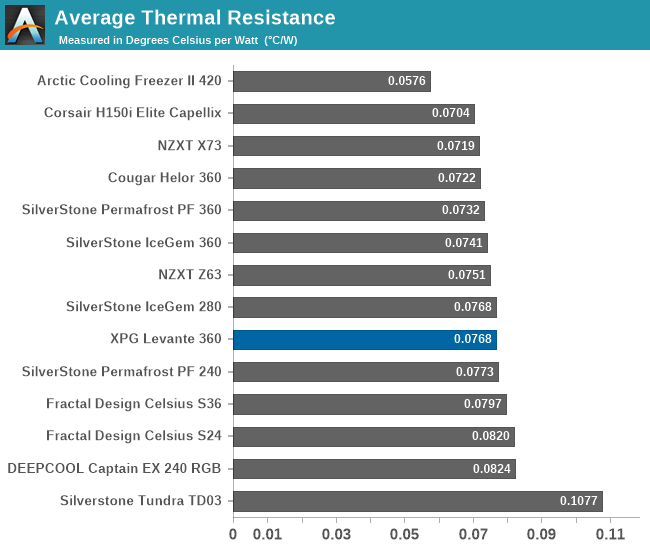
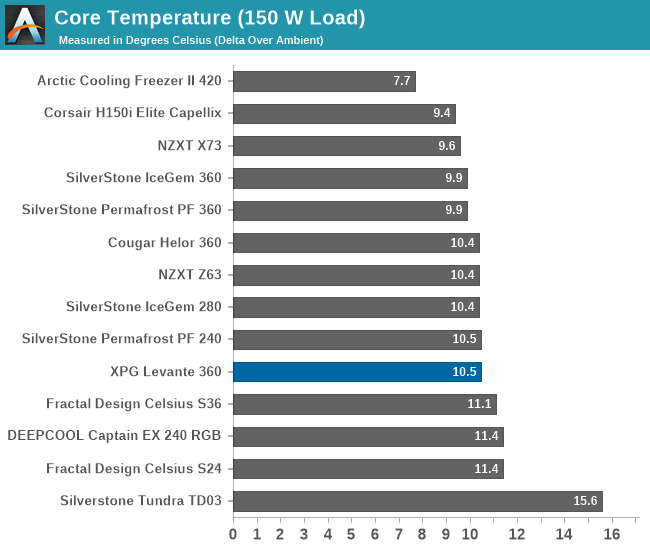
| Core Temperature, Constant Thermal Load (Max Fan Speed) |
The thermal performance of the XPG Levante 360 shows that the cooler performs about the same as other similarly-sized solutions, particularly those based on Asetek's reference design. The average thermal resistance of 0.0768 °C/W does not inspire awe for a cooler with such a massive radiator, but as one might expect, it's very close to the performance of other recent coolers with 360 mm radiators, which also puts it ahead of older coolers.
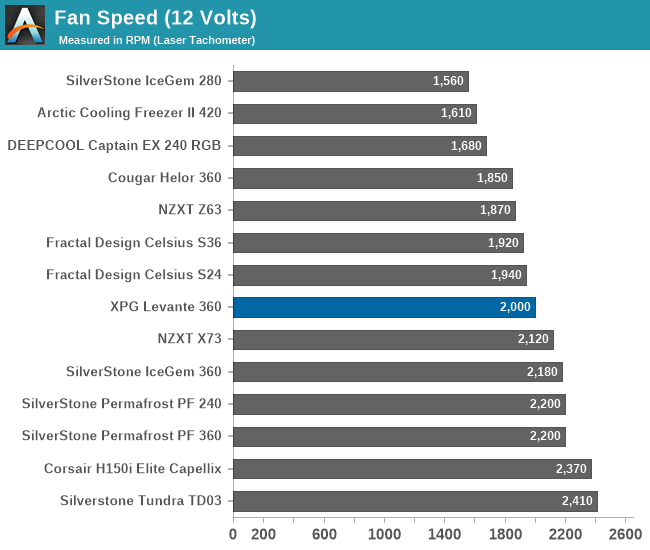
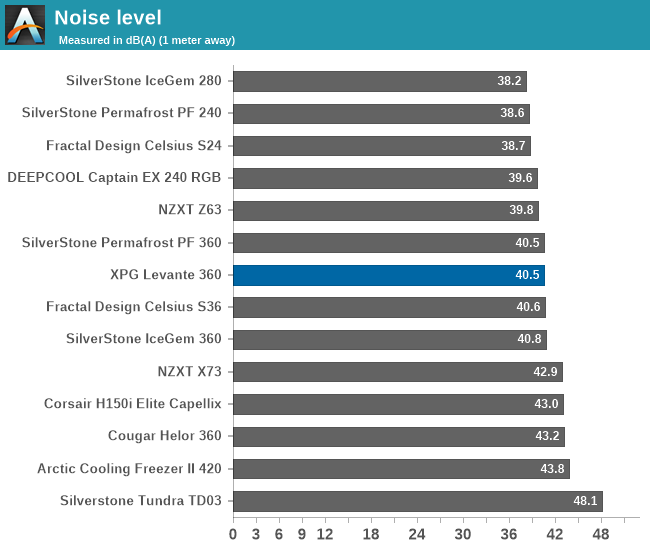
Three powerful 120 mm fans provide great airflow but they give a significant handicap to the Levante 360 when it comes to acoustics. With all three fans running at their maximum speed, we took a reading of 40.5 dB(A). This is not a bad figure for a cooler with three fans, but there are coolers that do it better, and such a loud cooler is not particularly comfortable for continuous use.
Testing Results, Low Fan Speed
Using a PWM voltage regulator, we reduced the speed of the fans manually down to half their rated speed, which is 1000 RPM for the Vento Pro 120 mm fans. The pump was also connected on the same power source, functioning properly at this low-speed setting.
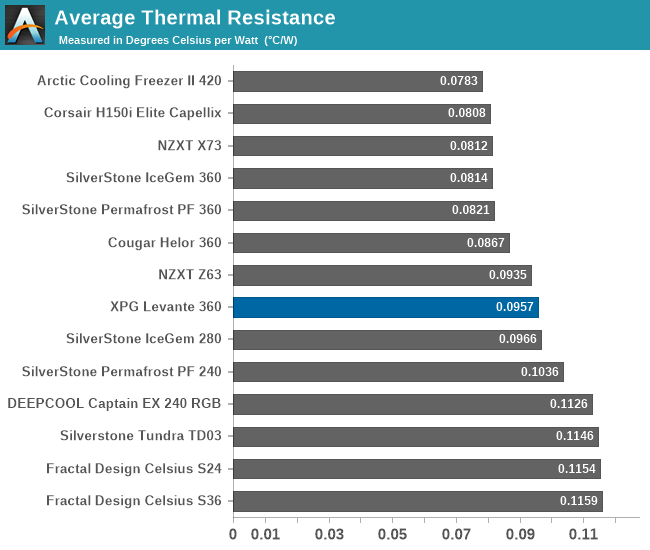
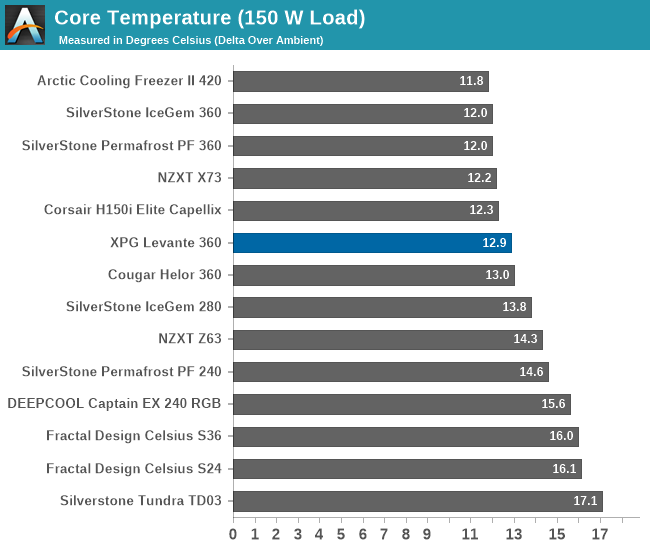
| Core Temperature, Constant Thermal Load (Low Fan Speed) |
This test initially suggests that the new XPG Levante 360 is significantly superior than older similarly sized coolers. With an average thermal permittance of 0.1036 °C/W, the Levante 360 is measurably better than older 360 mm coolers, such as the Fractal Design Celsius S36. However, a closer inspection reveals that the Levante 360 achieves this performance with its fans running at significantly higher speeds and, albeit the difference is minor, it does run louder.
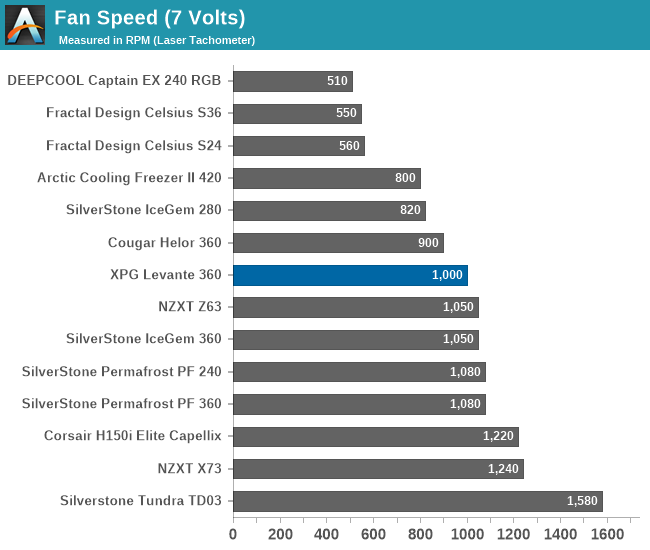
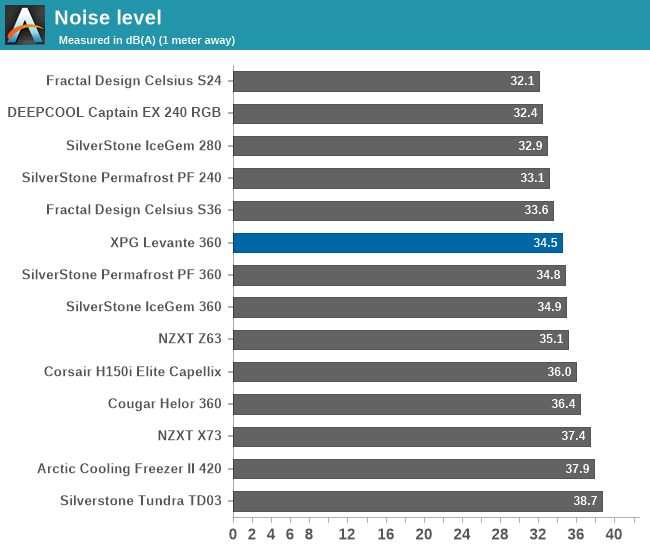
The noise output of the XPG Levante 360 under these operating conditions is 34.5 dB(A), a figure that is slightly audible but definitely comfortable for continuous use. The upside is that the pump is entirely silent, with no whining sounds or any form of noise coming from it, electromechanical or otherwise. The end result is that these noise figures are good for a cooler with three 120 mm fans, especially high-speed fans such as the Vento Pro.
Thermal Resistance VS Sound Pressure Level
During our thermal resistance vs. sound pressure level test, we maintain a steady 100W thermal load and assess the overall performance of the coolers by taking multiple temperature and sound pressure level readings within the operating range of the stock cooling fans. The result is a graph that depicts the absolute thermal resistance of the cooler in comparison to the noise generated. For both the sound pressure level and absolute thermal resistance readings, lower figures are better.
The graph displays that the XPG Levante 360 is a significant upgrade over older designs, capable of delivering significantly better thermal performance at the same sound pressure level. On the other hand, it brawls to compete with other recent releases of 360 mm radiator coolers, which tend to perform a little better and are capable of reaching lower thermal resistance figures. Compared to those coolers, the biggest advantage of the XPG Levante 360 is that it is capable of reaching lower noise levels, allowing the cooler to reach nearly inaudible noise figures while still delivering effective cooling performance.


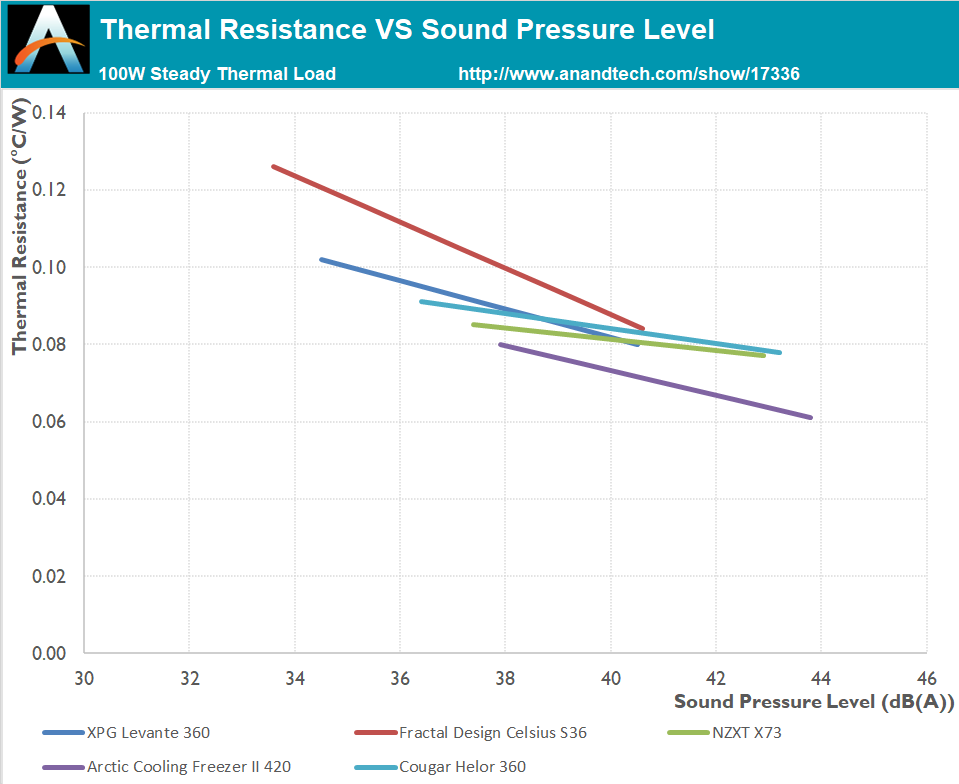








20 Comments
View All Comments
Oxford Guy - Tuesday, April 5, 2022 - link
Hacks are beside the point.Khanan - Tuesday, April 5, 2022 - link
Your comment is generally wrong. It doesn’t matter from which standpoint I look at it.With the demise of SLI and Crossfire GPU coolers are bigger than ever because there is no place reserved for the second gpu anymore.
Oxford Guy - Monday, April 11, 2022 - link
Bigger than ever? So what?It's still a lot less space and it's not at all optimal in terms of airflow.
zorikayvin12 - Saturday, April 30, 2022 - link
Burger King is an American multinational chain of fast-food restaurants.<a href="https://burgerkingbreakfastmenu.info/">Bur... King Breakfast Menu 2022</a>
zorikayvin12 - Saturday, April 30, 2022 - link
Burger King is an American multinational chain of fast-food restaurants. Burger King is the third-largest hamburger fast-food chain in the country.https://burgerkingbreakfastmenu.info/
Hifihedgehog - Friday, April 8, 2022 - link
> CPUs need so much space and money devoted to efficient cooling but GPUs do not.This statement needs some qualification and some tweaking. First, I think what you are trying to say is CPUs require additional spending for proper cooling, whereas most GPUs already come with adequate cooling out of the box. That ignores the fact that the third-party cooling solutions that vendors add above reference designs do increase prices above relase base MSRP. Second, your comment about space is inaccurate: GPUs are very much needing so much space for their stock cooling. The most recent offender is the RTX 3090 Ti, and before that the RTX 3090 Founders Edition. Worse yet, the recent round of rumors for RTX 40 series/Lovelace state that the RTX 3090 Ti is a mere taste for the cooling requirements that lie ahead, namely 450-800W power draw is expected for the next generation NVIDIA consumer flagship. All in all, your comment has some merit but is a bit out there since it ignores these points about the GPU space.
matthatnz! - Thursday, April 28, 2022 - link
https://asia.evga.com/products/product.aspx?pn=12G...Ah that statement is not really true. If you want better than normal cooling on a GPU (like these sort of cpu coolers provide) then just get the product above. I have had a EVGA 980 ti Hybrid for 6 years and its still going strong. Nevers gets over 60 degrees. MSI are now doig similar products as well. Standardisation of cooling soltuions is never gonna happen as board partners use custom PCB's so yeah nah.
matthatnz! - Thursday, April 28, 2022 - link
https://www.msi.com/Graphics-Card/GeForce-RTX-3080...Here is the MSI product. I can see more and more of these types coming out due to the TDP coming up of the 4000 Series from Nvidia
Foeketijn - Tuesday, May 17, 2022 - link
Other than the complications when trying to watercool the GPU, a GPU can be 90C° for ever without an issue. A CPU can't. Most GPU's are cooled propperly from factory, most (intel) CPU's aren't.The reason I would still Watercool my GPU is, I don't want that heat dispersed in my case.
maxmarrie - Monday, April 18, 2022 - link
This GPU is not working properly on my system and just because of this issue I am unable to complete my work